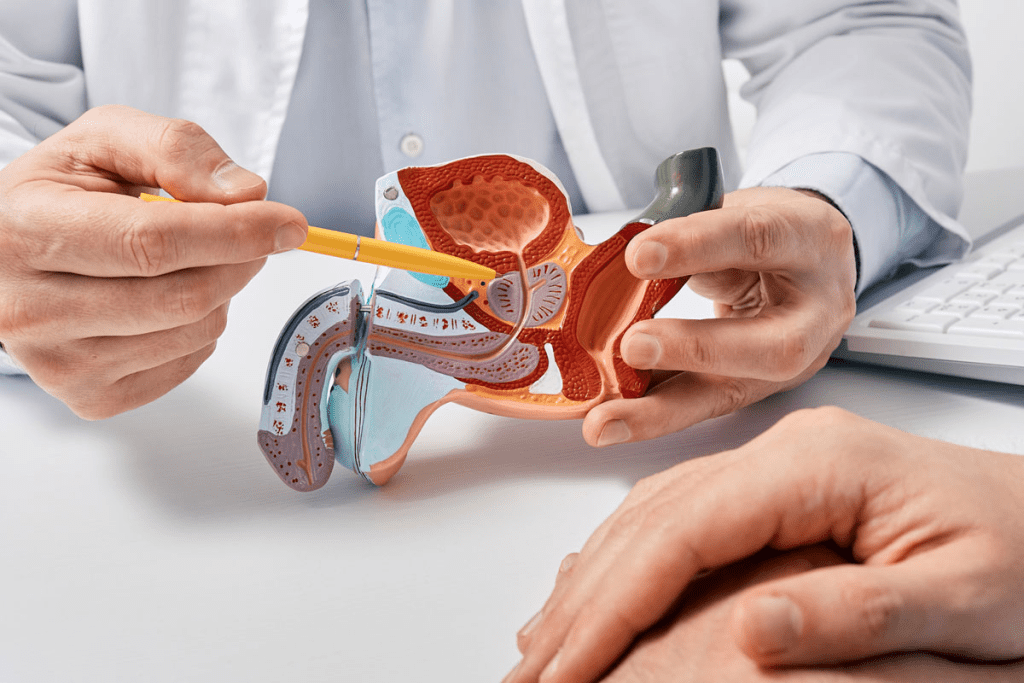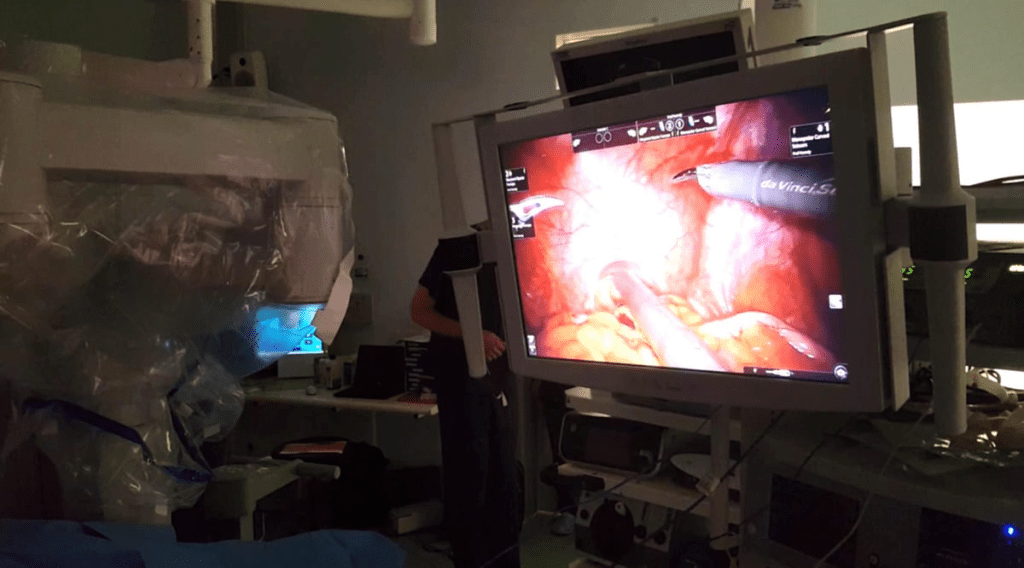Last Updated on November 25, 2025 by

Benign Prostatic Hyperplasia (BPH) is a common issue for many men. It causes annoying urinary problems. For years, Transurethral Resection of the Prostate (TURP) was seen as the top surgery for BPH that didn’t respond to medicine. Is there a better procedure than TURP? Compare the transurethral resection of the prostate to alternatives. Get information on BPH treatments.
New, less invasive prostate surgery options have come up. These include Holmium Laser Enucleation of the Prostate (HoLEP), UroLift, and Aquablation. They are being considered because they might cut down on hospital time, complications, and costs compared to old surgeries.
We will look into these new choices. We’ll talk about their good points and downsides in treating benign prostatic hyperplasia. This will give you a clear picture of how BPH is managed today.
Men with urinary issues need to know about Benign Prostatic Hyperplasia (BPH). It’s a big deal because it can really affect how you live. BPH makes the prostate gland grow too big, causing problems with urination.

BPH, or Benign Prostatic Hyperplasia, is when the prostate gets too big. It happens as men get older. This can make it hard to pee, pee a lot, or start and stop peeing easily. The symptoms can get worse over time if not treated.
At first, doctors might try medicine or changes in your life to help. But if these don’t work, surgery might be needed. This is when BPH symptoms are really bad, like not being able to pee at all, or when you keep getting infections.
More and more men are choosing less invasive surgeries for BPH. By 2024, 35.7% of BPH treatments will be these new methods. They’re popular because they help you recover faster and have fewer side effects. HoLEP and UroLift are two examples that are safer than old methods like TURP.
As more men look for new ways to treat BPH, it’s key to know what’s out there. We aim to give you all the info you need to make the best choice for your health.
TURP is the top choice for treating BPH because it works well. It’s a surgery that has improved over time to tackle BPH problems.

The TURP procedure removes prostate tissue that blocks urine flow. We use a special tool called a resectoscope. It goes through the urethra to see the prostate and remove extra tissue.
This method is less invasive than other surgeries. It doesn’t need big cuts, which lowers the risk of problems and helps you heal faster. TURP directly tackles the prostate tissue that’s causing trouble, making it easier to pee for men with BPH.
Many studies show TURP greatly helps with BPH symptoms. Most patients say their symptoms are much better after TURP. They also see big improvements in their scores for pee problems.
TURP is the top choice for treating BPH because it works so well. It makes it easier to pee by removing the blockage, improving life for men with BPH.
Recovery time after TURP varies, but most men get back to normal in a few weeks. At first, they might pee more or feel some discomfort, but this usually goes away as they heal.
We give patients a care plan to help them recover smoothly. This plan might include using a catheter for a bit and follow-up visits to check on healing and answer any questions.
Even though TURP is safe, some problems can happen. These include bleeding, pee leaks, and issues with ejaculation. While these are rare, it’s good to know about them before choosing TURP.
Common complications and their management:
Knowing the good and bad about TURP helps patients make the best choice for their treatment. As the top treatment for BPH, TURP keeps giving men relief from enlarged prostate symptoms.
Laser-based procedures are becoming popular as alternatives to TURP. Treatments like HoLEP and GreenLight Laser PVP are known for faster recovery and fewer side effects.
HoLEP is a safe and effective way to treat BPH. It uses a holmium laser to remove prostate tissue. It’s good for treating larger prostates and has fewer complications than TURP.
GreenLight Laser PVP is another good option. It offers similar results to TURP but with shorter hospital stays. This method uses a GreenLight laser to vaporize prostate tissue. It’s precise, which means less damage to nearby tissues.
Laser procedures like HoLEP and GreenLight Laser PVP have shorter recovery times. They also cause less pain and fewer complications. Here are some key differences:
Considering these points helps patients and doctors choose the best treatment for BPH.
Minimally Invasive Surgical Treatments (MIST) are changing how we treat Benign Prostatic Hyperplasia (BPH). They offer faster recovery and fewer side effects. In 2024, MIST made up 35.7% of BPH procedures, showing more people want quick and safe treatments.
UroLift is a special procedure that moves prostatic tissue apart. It helps relieve blockage without harming or removing tissue. This method also keeps sexual function intact. Clinical trials show it greatly improves symptoms with little side effects.
Rezum Water Vapor Therapy uses steam to kill prostatic tissue. It works well for various prostate sizes and shapes. It’s done in one session under local anesthesia, making it comfortable and convenient for patients.
Aquablation uses a robotic water jet to remove tissue. It’s precise and keeps important areas safe. A study in World Journal of Men’s Health shows it’s safe and effective.
TUIP makes small cuts in the prostate to ease blockage. It’s good for men with smaller prostates. It has a quick recovery and fewer complications than big surgeries.
Knowing about MIST options helps patients choose the best treatment. As medical tech improves, MIST will likely play a bigger role in treating BPH. This offers hope for men looking for relief from BPH.
Men with BPH might find PAE a good option. PAE is a way to shrink the prostate by cutting off its blood supply. This helps ease BPH symptoms.
An interventional radiologist does the PAE procedure. They use imaging to find the prostate’s arteries. Then, they block these arteries with a small catheter.
This method is less risky than surgery. It also helps keep sexual function intact. Many studies show PAE works well for BPH symptoms without harming sex life.
PAE is great for keeping sex life intact. Clinical trials show PAE keeps erectile function better than TURP. This is good news for men worried about BPH treatments affecting their sex life.
PAE doesn’t harm nearby tissues or nerves. This lowers the risk of sexual problems seen with more invasive surgeries.
PAE has better recovery times than TURP. Most patients can get back to normal in just a few days. TURP, on the other hand, can take longer and might require a hospital stay.
PAE’s minimally invasive nature means fewer complications. This makes it a good choice for those wanting quick recovery.
PAE is not for everyone. It’s best for those with moderate to severe BPH symptoms. They should want a non-invasive option and care about keeping their sex life intact.
Before trying PAE, talk to a healthcare provider. They’ll check if PAE is right for you, based on your health, prostate size, and other conditions.
When looking at BPH treatments, it’s key to know how each one works. We’ll look at studies on TURP, HoLEP, UroLift, and Rezum. We’ll focus on symptom relief, how long you stay in the hospital, and how often you might need more treatment.
Improving symptoms is what patients with BPH want most. TURP and HoLEP are top choices for this. They both greatly reduce symptoms, with HoLEP sometimes doing a bit better.
UroLift and Rezum also help a lot, but not as much as TURP and HoLEP. They’re good for those who want to get back to normal life quickly and with fewer side effects.
How long you stay in the hospital matters a lot. TURP and HoLEP usually mean just one night. But UroLift and Rezum can be done without staying overnight, so you can go home the same day.
How often you might need more treatment is important. TURP has a good track record, but HoLEP might be better in the long run. A study showed HoLEP has fewer repeat treatments after 5 years.
Newer treatments like UroLift and Rezum are promising but need more time to show their long-term success. Early results look good, though.
Quality of life is more than just symptoms. It includes sex life, being able to control your bladder, and feeling well overall. TURP and HoLEP can really improve your life, but they can also cause problems like sex issues and leaks.
On the other hand, UroLift and Rezum aim to avoid these problems. UroLift helps keep sex life intact for most men. Rezum also looks good for keeping sex life healthy.
By looking at these points, you and your doctor can choose the best BPH treatment. It’s all about finding the right balance between how well it works, how quick you recover, and any possible side effects.
Choosing the right treatment for Benign Prostatic Hyperplasia (BPH) is important. We’ve looked at different BPH surgery options. These include TURP, HoLEP, UroLift, Rezum, and PAE, each with its own benefits and drawbacks.
When picking a prostate surgery, size of the prostate, health, and personal wishes matter. Knowing about the different procedures helps patients make better choices. This can greatly improve their life quality.
It’s wise to think about what each BPH treatment offers. For example, TURP helps with symptoms, while HoLEP is better for bigger prostates. UroLift and Rezum are less invasive. PAE is good for keeping sexual function.
By considering these points and talking to a doctor, men can find the best BPH surgery for them. This ensures the best results.
BPH is a common issue in men, causing weak urine flow and dribbling. Treatments include medicines and surgeries like TURP, HoLEP, UroLift, and Rezum.
TURP is a surgery that removes extra prostate tissue to ease symptoms. It’s been a top choice for BPH treatment for years.
TURP can lead to bleeding, incontinence, and sexual problems. But, new surgical methods have reduced these risks.
Options include laser surgeries like HoLEP and GreenLight Laser PVP. Also, there are minimally invasive treatments like UroLift, Rezum, and Aquablation.
HoLEP uses lasers and might have fewer complications and quicker healing than TURP.
UroLift lifts prostate tissue to improve urine flow. It’s quick, painless, and has few side effects.
PAE blocks blood flow to the prostate to shrink it. It’s a new option that might preserve sexual function.
The right procedure depends on your symptoms, health, and preferences. Talking to a healthcare professional is key to finding the best treatment.
Recovery times vary. TURP takes a few days to a week. UroLift and Rezum might allow for quicker healing.
Some surgeries, like TURP, might impact sexual function. But, PAE and UroLift aim to preserve it. Always discuss sexual concerns with your doctor.
Subscribe to our e-newsletter to stay informed about the latest innovations in the world of health and exclusive offers!